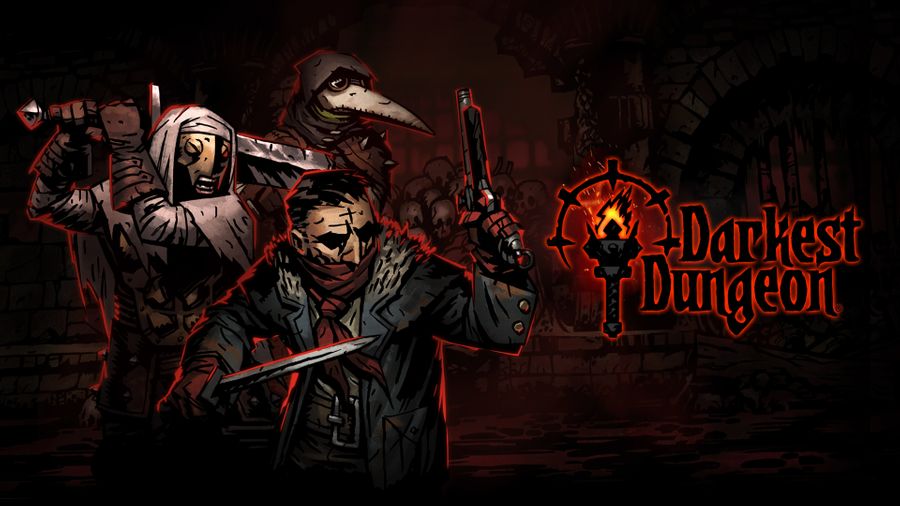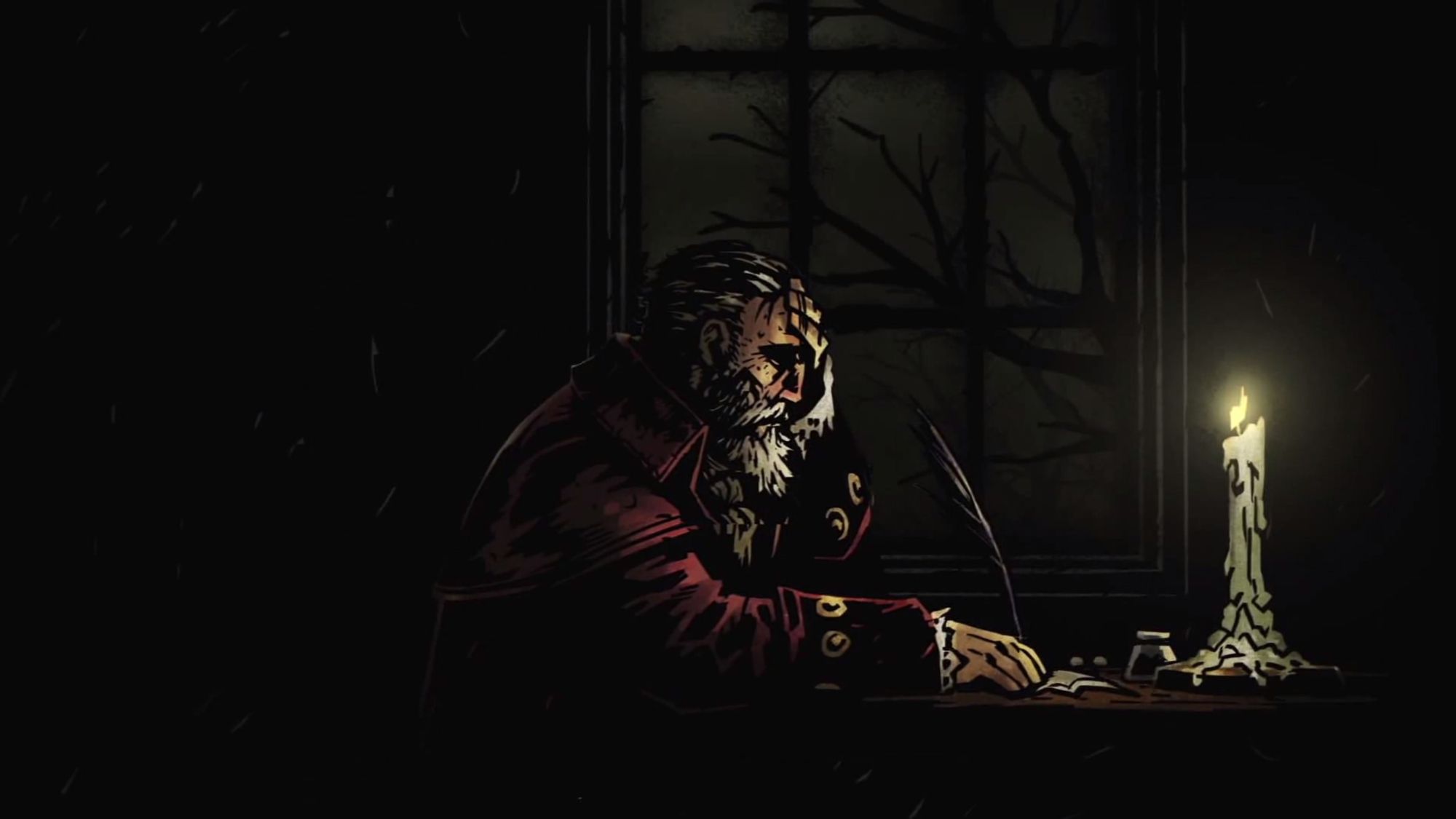
Hoo, boy. Where to start.
Well, what about the fact that this review is two and a half years in the making.
When I started playing Darkest Dungeon I hadn't gotten married to the love of my life. I was still working in my dead-end, unpleasant job. My Ravenwing and Tau hadn't been stolen yet. The year was 2017.
And yet, halfway through 2020, some four years after the game's release, I stand atop the mountain with a game completion in one hand and a well-overdue review in the other. This is as much about making sure I am fair to the game as a milestone of how I've come as a person.
Of course, that's a bit dramatic, so what gives?
The short answer is that Darkest Dungeon is an immaculate game. It is a video game title I would consider to be perfect. Even as I sit down to write this review, I'm honestly just going to sing the game's praises. If you read past this point, buckle up - because I'm about to force feed you a metric ton of glowing praise.
But just before that, I have a self indulgent anecdote to share with you. The reason this game took so long is as a result of one particular soul-crushing moment I experienced whilst playing the game. It requires some context to understand and Darkest Dungeon is very story rich, so I will do my best to explain in a very vague fashion.
Darkest Dungeon has two excellent expansions - one of which introduces a mechanic which permanently inflicts a status condition on your characters. Each boss from the additional content you defeat (four in total) cures your characters. But once you get to the fourth boss, there are no more reprieves. either your entire roster gets afflicted with enough time, or you manage to defeat the boss. During my first stretch with the game (a hundred hours plus, countless late nights, etc.) I came within a turn of defeating the foul creature and moving on with the game. I could feel my spirit lift as I realised I was about to overcome a major obstacle in my playthrough.
Then came the most soul-crushing series of events I have ever encountered. A series of events totally on brand for Darkest Dungeon - and even without context, it perfectly encapsulates both my favourite and hated parts of the game.
In three turns, the boss killed three heroes, healed herself out of range of my last hero and I knew I had lost. I was furious. I don't think I've been so quietly angry at a video game before or since. I uninstalled the game on the spot, not even finishing the encounter and quietly packed the game away into the corner of my mind.
For the next two years, I let it sit at the back of my mind. I considered returning to it every once in awhile, only to be reminded of that punishing encounter and deciding it was not worth it.
Then, about a month ago, it forced its way to the forefront of my mind. It told me with the right knowledge and background research, I could defeat this evil and move on. So I made a deal with myself. I would reinstall Darkest Dungeon - if my save was there, super - I would continue on. If not, well, it's a bust.
Steam cloud saves the day. Kind of. It transported me right back to the end of the encounter, one character left. Welcome back, here's your reminder of the stark pain you experienced. And that was my reintroduction. Welcome back, moron - remember that time you royally screwed up and got three people killed? No? Here it is.
That was a torturously prolonged anecdote, so let me tell you about Darkest Dungeon. It's a turn-based tactics roleplaying game set in the 18th century, featuring themes such as cosmic horror, psychological scarring, imperfect people doing the best they can and above all, hopelessness. And, just in case I haven't said so before, it's beautiful - but also horrible.
The intro cinematic makes it very clear. You recieve a letter from your ancestor informing you that he's done some evil things (that he conveniently refuses to specify, other than that he found an eldritch horror at the bottom of your family manor) and that it now lies in ruins, and you should come along and jolly well sort it out. It'll be fun and you can invite all your friends.

From the outset, you are greeted with a message from the developers. It explains your goals and perils in simple terms. The game autosaves after every decision - and you can't turn it off. Your characters will bend under the strain you put them under, and they break easily. This is not a cutesy game like Persona 5 - it will be a hard slog and every decision matters:
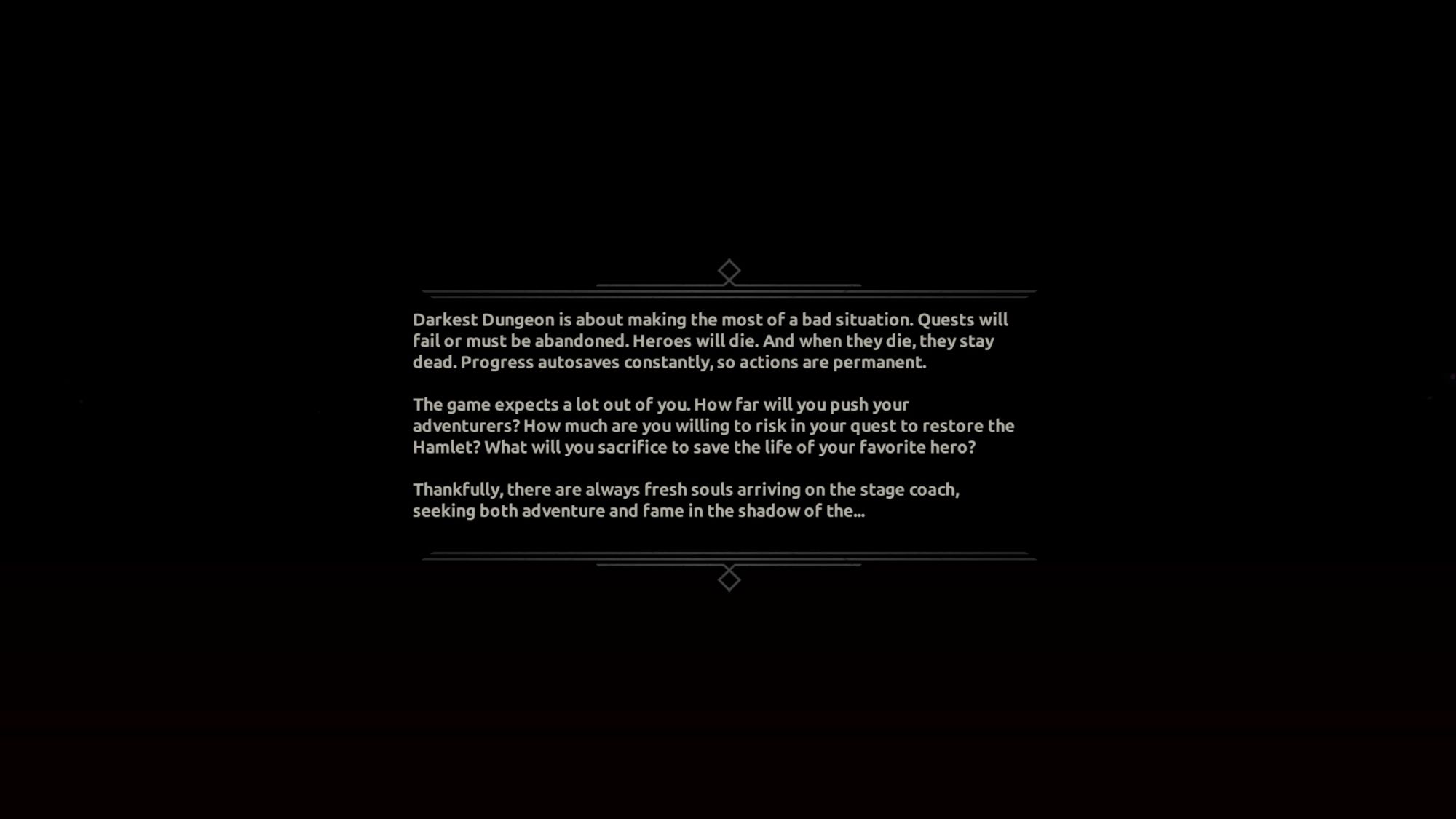
Your first task is to reach your base of operations - a little hamlet operating in support of the manor. You get a well-tutorialised introductory sequence that doesn't hold your hand and has you learning by doing. Your reward? Well, it's to reach the dump that your ancestor neglected:

In time, you will use the resources gained from your expeditions in the tainted areas near the manor to upgrade it. The sprites change as you implement upgrades to your hamlet, giving you a sense of investment as you seek to improve the hamlet - or at least make it not a dump. Each of the main buildings serve an important purpose. But to talk about them, first we have to talk about Heroes - the living building blocks of this world.
As noted above, the themes of imperfect people, next broken man up and psychological scarring play out almost immediately. Your first two heroes are a Crusader - morally upstanding bloke - and a Highwayman, who robs people at gunpoint. But they're both here and they're both in for the long haul, so who are you to tell either of them to take their services elsewhere?
The entire game is like this. Through the game's fifteen different classes, you will deal with Bounty Hunters, Grave Robbers, Occultists, Werewolves and many more besides. These are broken people, criminals, the scum of society. But if you bring them into your fold, they will be your scum. It is delicious juxtaposition - you have recruited these Heroes and got invested in them - but the game will force you to throw them away at a moment's notice. That is your first big warning that Darkest Dungeon is not on your side. It wants to you become broken like the mopes you pull off the stagecoach and press into service. And maybe, just maybe, it wants you to savor that feeling just a little, too.
So, naturally, I named all my heroes after family members and friends and kept track of how often they died.

So in the first ten minutes you have your taste of the core gameplay loop. Embark on a journey, (hopefully) no-one dies, (hopefully) bring home some loot, hire some more mooks, buy equipment (if you really need to) upgrade your facilities (if you can). Tight, focussed, well designed.
It says something about how well designed the gameplay loop is that I never considered it to be tedious, or wasting my time. The hallmark of any good RPG is how little you think about the gameplay loop and how you enjoy each quarter-turn instead.
But that's also because of the other part of Darkest Dungeon. The Dungeon component. Buckle up, because there's nothing truly like this in the market today.
The first part is quite mundane. You're given a choice of four locations (five with the Crimson Court DLC, six with the Color of Madness DLC).

You then assemble a party. Initially, you have one option - the two folk you pulled from the stagecoach. But as the game develops and you get more scum off the wagon, there are so many different combinations of adventuring parties and items. If you're a pedant like me, you'll often find yourself making notes of your most successful parties, so you can return to them in future dungeons. It's a tiny mechanical detail, but made possible by Darkest Dungeon's tremendous depth.
As you progress further in the game and develop more experienced heroes, they refuse to go into dungeons that are too low a level for them, ensuring that you will always be presented with a challenge. This also means you are always gambling with the lives of your heroes - so you have to make it count.
With our party decided, it's off to the quartermaster to provision us for the journey to come. You'll need food - broken heroes don't like to fight on an empty stomach (but they can. For a while) Torches for light, shovels to clear obstacles. If you're a rich man, maybe you pack bandages or keys. But resources are tight and you're not made of money. Surely your team can survive a few bumps and bruises.
Again there are these little details that really add to the sense that the deck is stacked against you. You're relying on Heroes to reclaim your manor, but how much are they worth? Do you provide a bunch of rookies with bandages, expensive anti-venoms and keys? Or do you just give them the bare minimum and hope it's enough to get you over the line.
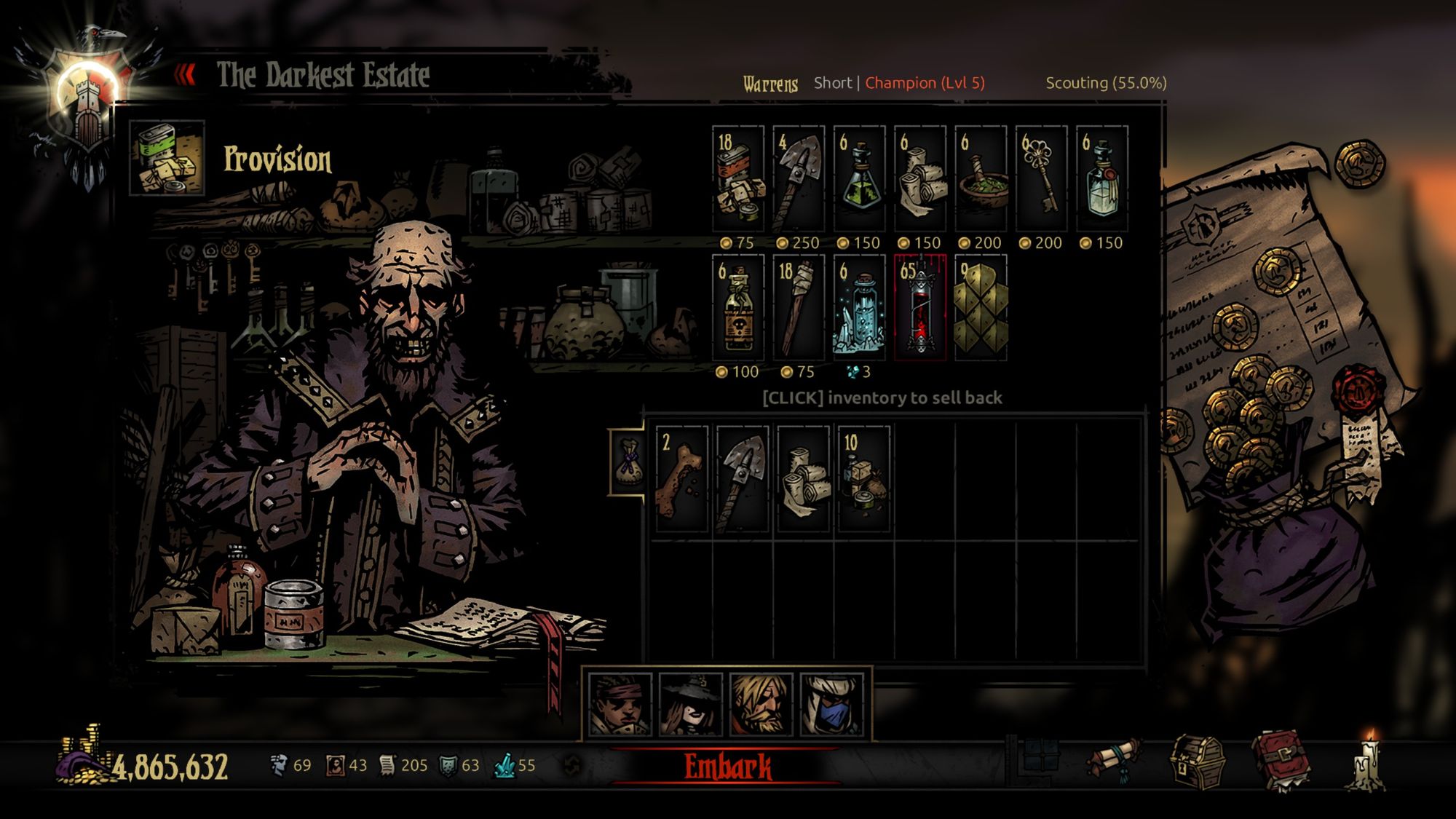
Having now embarked, we're going enter the largest part of Darkest Dungeon. It in itself is a mini gameplay loop. A wheel within a wheel, if you will.
All dungeons, with some exceptions for bosses and story missions, have a random layout. You will be given an objective from the outset. Maybe it's to clear out the dungeon of bad guys. It could involve scouting rooms - or interacting with special objects in the world. Each location has different layouts characteristic to their random generation.
When inside the dungeon, you move along a preset path from room to room. Along the way you will encounter items and enemies (generally) unique to that location.

In the ruins, for example, you will encounter a lot of undead, whilst in a location like the cove, you're dealing with mostly corrupted sea creatures.
Whilst you're here, you should take in the immaculate visual design of the location. Art style aids immersion and this is definitely true here. Everything in the game has a consistent visual tone - dark with lots of shading and very little color. It helps to bring across the game's themes and really reinforces that aura of hopelessness.
As you move through an area, your light meter steadily runs down. As the world around you gets darker, the monsters become more powerful. And your heroes become more stressed, increasing the chance they will break, rather than bend, under pressure. But there's a tradeoff. With less light comes more treasure. There's a risk and reward mechanic at play here - and is yet another of the game's tiny details which shows how much thought, care and craft the game's designers have put into each mechanic. There's nothing wasted.
But now that the cat's out of the bag about heroes bending and breaking, let's talk about the combat.
As to be expected of a turn-based tactics RPG, Heroes and enemies take turns using abilities on each other. Some deal damage, some heal damage. But Darkest Dungeon's utterly unique mechanic is something rarely tackled in other games - stress.
In a world filled with broken people, in a place filled with terrible adversity, your Heroes are just human. Stress is a gameplay mechanic intended to represent this. It is an abstraction, of course - but its implementation is perfect.
Stress, from a mechanical standpoint, functions as a second health bar. As a hero is subjected to stressful events (enemy abilities, traps, interactions with some dungeon curios), this bar gradually fills up. When it becomes full, the character makes an unseen virtue check. This is to decide what happens when you have pushed your hero too far.
Will they bend?

Or will they break.

But that's not the end of the road. You can choose to push on with a mentally damaged team member. It's an awful thing to do, but remember what the developers talked about. It's a decision they put in your hands - how far will you go to accomplish an objective? What does that say about you?
If you push on, your mentally scarred character will behave like someone struggling through a mental episode. They will act unpredictably, hurting either themselves or members of the team. They will not listen to your directions. Through actions in the dungeon, the player has turned the Hero into a liability.
But that's not all. The Hero's stress meter now starts to fill again. It fills quicker this time and can often start a chain reaction amongst your party. If you fill it a second time, your character has a heart attack, taking the character instantly to zero health. Well done, you monster - you have pushed a Hero so far past the breaking point, they self destruct. Red Hook, the game's developers, clearly wanted the player to understand - and feel the consequences of letting a broken hero continue on. And blow me down if they don't completely nail it.
But there's one more unique mechanic at play here. When a character reaches zero health, they don't die. They instead go into a state called "Death's Door" - indicating the character is about to die and if the player doesn't take action to heal them, they'll perish. Every time a hero suffers damage whilst on Death's Door, there is a one in three (33%) chance of suffering a "Deathblow" - that is to say, the character dies. For real.

Now, my nonexistent readership may ask. "Why not just let a character that gets to zero health just die?" the answer is remarkably simple - it creates real life stress and tension. And in a brilliant reflection of gameplay mechanics, inflicts the stress your team feels whilst on death's door, right on you.
Do you immediately heal a character on Death's Door, knowing that the subsequent loss of offensive pressure may just cause the scenario to repeat itself? Do you develop superstitions like crossing your fingers, or saying a little prayer to RNGesus when a character on Death's Door has a recurring damage effect, thus causing one trouser-tightening moment where you're not sure you'll get a chance to save your most precious hero?
In the end, it may all be for naught. But don't fret, there will be fresh meat on the wagon tomorrow.
So we've learned about what happens when you psychologically torture your heroes. We've learned how they die. But let's get into the meat - the combat.

Normally RPGs have both sides line up and attack each other. Darkest Dungeon is like this too - except your position in the line dictates what abilities you can use. It also dictates who you can use your abilities on. This ties into the team composition before you set out. If you don't get your team composition right, you're putting your heroes at risk. Not ideal.
Because of concepts like positioning, the combat is multilayered. It's easy to learn, yet hard to master. With fifteen different classes, there's a lot to cover and explore. Each class has eight different abilities and can be equipped with four at any given time, allowing each hero to cover several different potential roles. Mostly. Some classes, like the Man-At-Arms, will always be tanky brick walls.
Darkest Dungeon makes good use of mechanics like characters that move around, such as the Shieldbreaker - who has a powerful armor piercing attack, but who has to move forward to use it. Or the Highwayman, who is able to inflict massive damage - but needs to be at the front of the team to use it and the recoil moves him back a space.
There's also guarding, which allows you to protect weaker members of your team with stronger ones - and riposte, which provides a hero with a counter-attack when targeted. There's also bleed and blight - each one inflicting damage over time, with different preferred targets. Different enemies have different vulnerabilities - and it's up to you, the player, to exploit them.

One of Darkest Dungeon's strengths - at least in terms of the combat - is that though there is a lot of ground to cover, the mechanics used are explained in universally recognized terminology. Buff and debuff, damage modifiers, any additional parts of an attack - are explained in a simple and easily read format. You're never at risk of doing something you don't want to do. This means that when you stuff up and lose someone, it's not the game's fault.
As if to hold up a mirror to the player and their team of heroes, almost all of the mechanics of the game are symmetrical. Concepts like guarding, riposting, bleed, blight and healing are all abilities the enemy has access to. You can clearly and quickly understand what the enemy is doing - though you may find it harder to prevent them from enacting their plan. The AI is intelligent and challenging - and if you're not very clever, it'll clean you up before you can retreat.
Of course, assume your heroes complete the quest and get out alive, your obligations don't end there. Your character inherit vices and quirks - and if you're particularly unlucky, they also recieve diseases. These can all range from harmless things like only wanting to meditate to relieve stress, all the way up to compulsively interact with things in the environment. If you're lucky, you'll be able to limit your Heroes' vices and keep them free of disease - but cures and treatments cost money (quite a lot of money) - and that doesn't grow on trees.
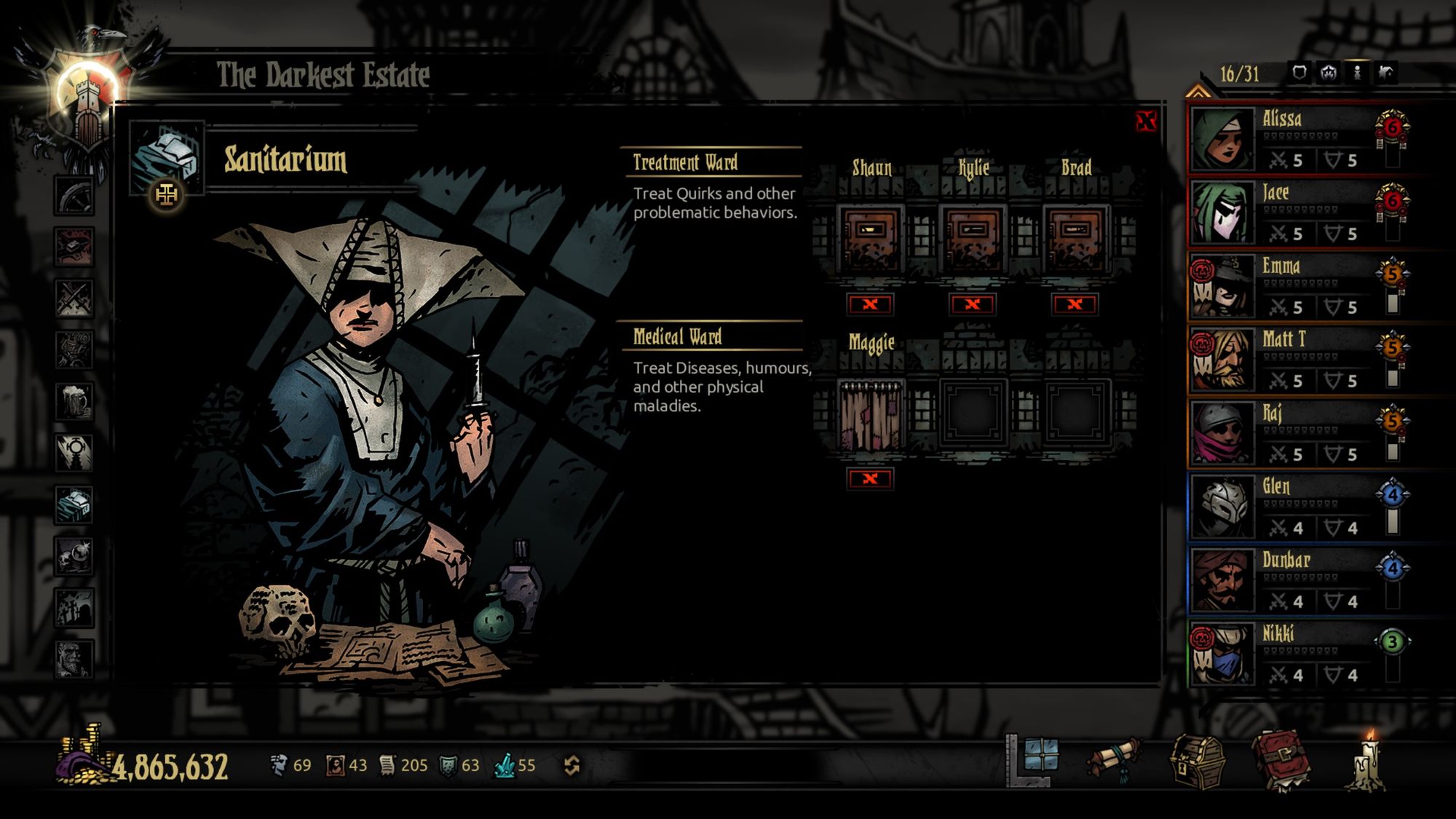
Unlike other roleplaying games, Darkest Dungeon is always challenging the player. I have played many RPGs where the first half of the game is the challenging slog up the hill. Resources are an issue, keeping everyone in good gear is an issue. The fights are hard and arduous. Then you crest the hill at some unforeseen turning point and you start going downhill.
Darkest Dungeon never does this. Characters above a certain level are prevented from carrying their rookie team-mates into low level dungeons. Rookies freak out when you take them into more difficult Dungeons. You're losing Heroes so often your ability to adapt and negotiate an ever changing roster of heroes is always required. Darkest Dungeon is always hard and always challenging. Even with advanced trinkets, there's never a set of trinkets so powerful that the game just magically breaks open.
These mechanics are what cause me to have my love/hate relationship with Darkest Dungeon. It's impossible depth of classes, trinkets and enemies, combined with groundbreaking immersive mechanics like stress - they truly make a cocktail of an outstanding core combat loop. But the game can feel remarkably unfair at times, even when it isn't. You'll feel the frustration when you lose a Hero to a damage over time ability you could've healed. You'll fail a virtue check even when you take items that boost your chances of being virtous. It's why, even after finishing the game, I still cannot put it down - but I still get just a teeny bit frustrated and stressed when characters are on Death's Door.
But the other key part of this story is that (unless you play on the most difficult game mode because you're mad, like the people in the hamlet) Darkest Dungeon has no failure state. You can have your entire roster of heroes stomped into jelly - and you'll always be able to scrape together a fresh grip of idiots to herd into the dungeons to be mulched. You are always free to try again. Almost as if the game is taunting you - it beat you so bad your entire team left in a body bag. But it'll wait. and wait. and wait. Even now the thought of that mechanic fills me with enthusiasm.
Whilst you're busy fighting (and dying) your way through the hamlet, you're learning about the world around you. Darkest Dungeon tells its tale a lot like Dark Souls - there's a lot of showing and not so much telling.
Though the game is not entirely without narration. Infact, quite the opposite. The Ancestor narrates your journeys in a forboding voice, in vague and unsettling terms. Every fight, every looting opportunity. His dialogue is well written - and is constantly reminding you of the dangers of the world around you. He also has small amounts of cumulative points of exposition when facing off against bosses. Though my criticism there is that unless you listen to the other previous parts of the game, you'll often forget the previous parts. I'd suggest re-listening to them as a whole upon completion of the boss arcs. But they are well worth the listen.
As the ancestor explains more and you make more journeys, you understand the depths of depravity your ancestor has plumbed. His dark deeds, horrible ways and odd penchant for the blood. In the perfect example of "show, don't tell" the Crimson Court DLC introduces special items unique to each character which provide set bonuses - and also dialogue about each character. Nearly all tragic - and providing a dimension you never thought you needed, but intrigued you nonetheless.
All the while, your battles are covered by some truly excellent soundtrack, each one telling a story in its own right. From the miserable, run-down village:
Then contrast that with the big sounds when you're battling through the Warrens:
Masterful. Truly, truly masterful - and all put together by skilled composer Stuart Chatwood.
In addition to the immersive mechanics and excellent sound design, the visual design is outstanding. It perfectly encapsulates the 18th century dark, gothic horror the game evokes through sound and mechanics. The character designs are all totally unique and immediately recognizable. Not to mention the care and thought put into the combat animations - all of which look stunning in 144hz:
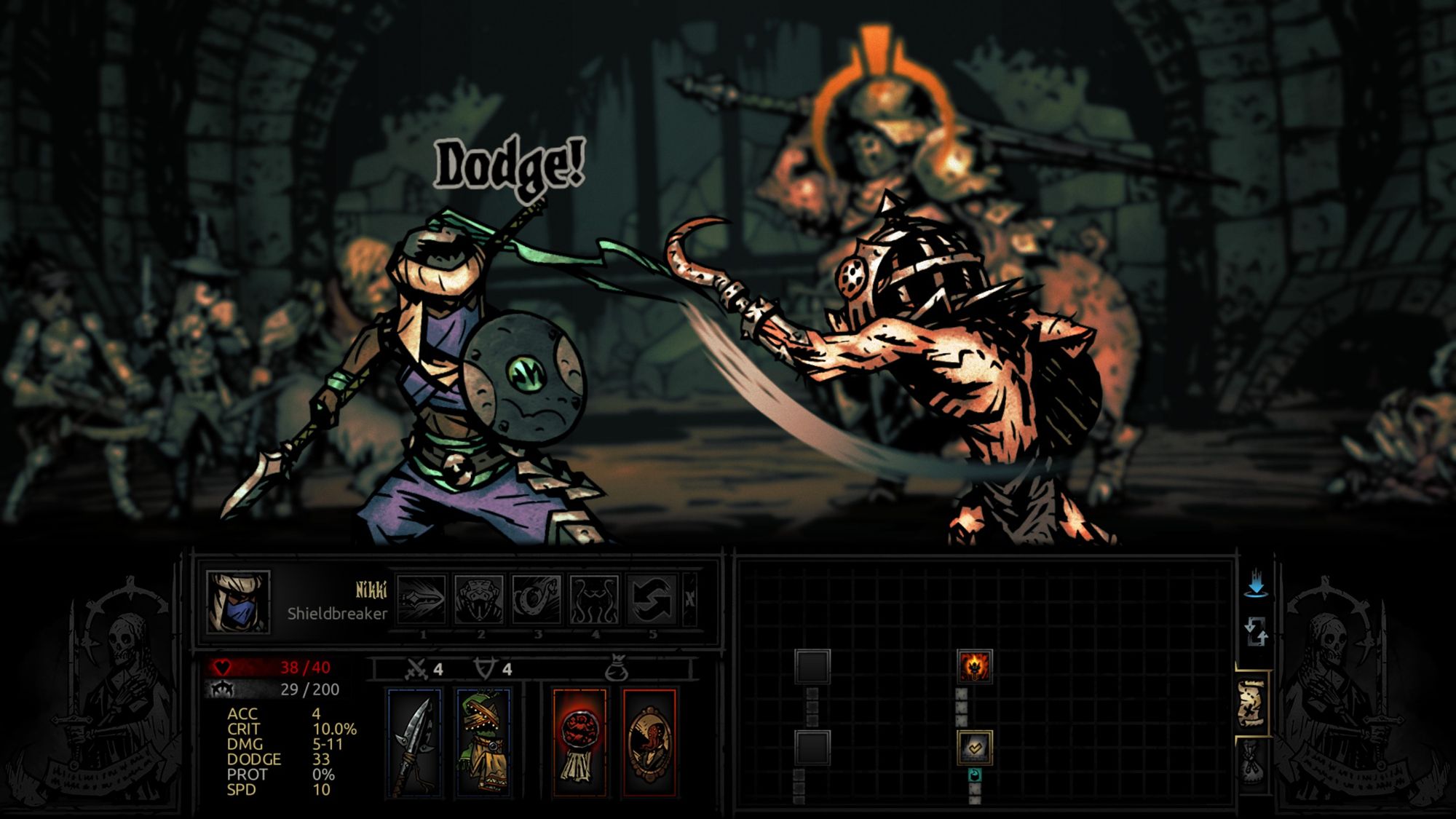
It's certainly a vote of confidence - much like Persona 5 - that style often can deliver a much more immersive experience than the overwhelming pursuit of realism. I cannot imagine Darkest Dungeon without its art style - and I'm glad I don't have to.
If all of that wasn't enough, these days you can pickup the Ancestral edition of Darkest Dungeon, which includes the two expansion packs. And we kind of have to talk about those separately. Kind of. You can play the whole campaign from start to finish with these two added and they help as neat tie-ins for the main game.
Let's start with the source of my anecdote, the Crimson Court.
The Crimson Court adds an entirely new area - the Courtyard, where the 18th century aristocracy of the area partied and indulged too much. Driven mad by a substance called "The Blood", this area sees you fight four bosses (three mandatory and one optional) and includes a brand new incurable status for your heroes.
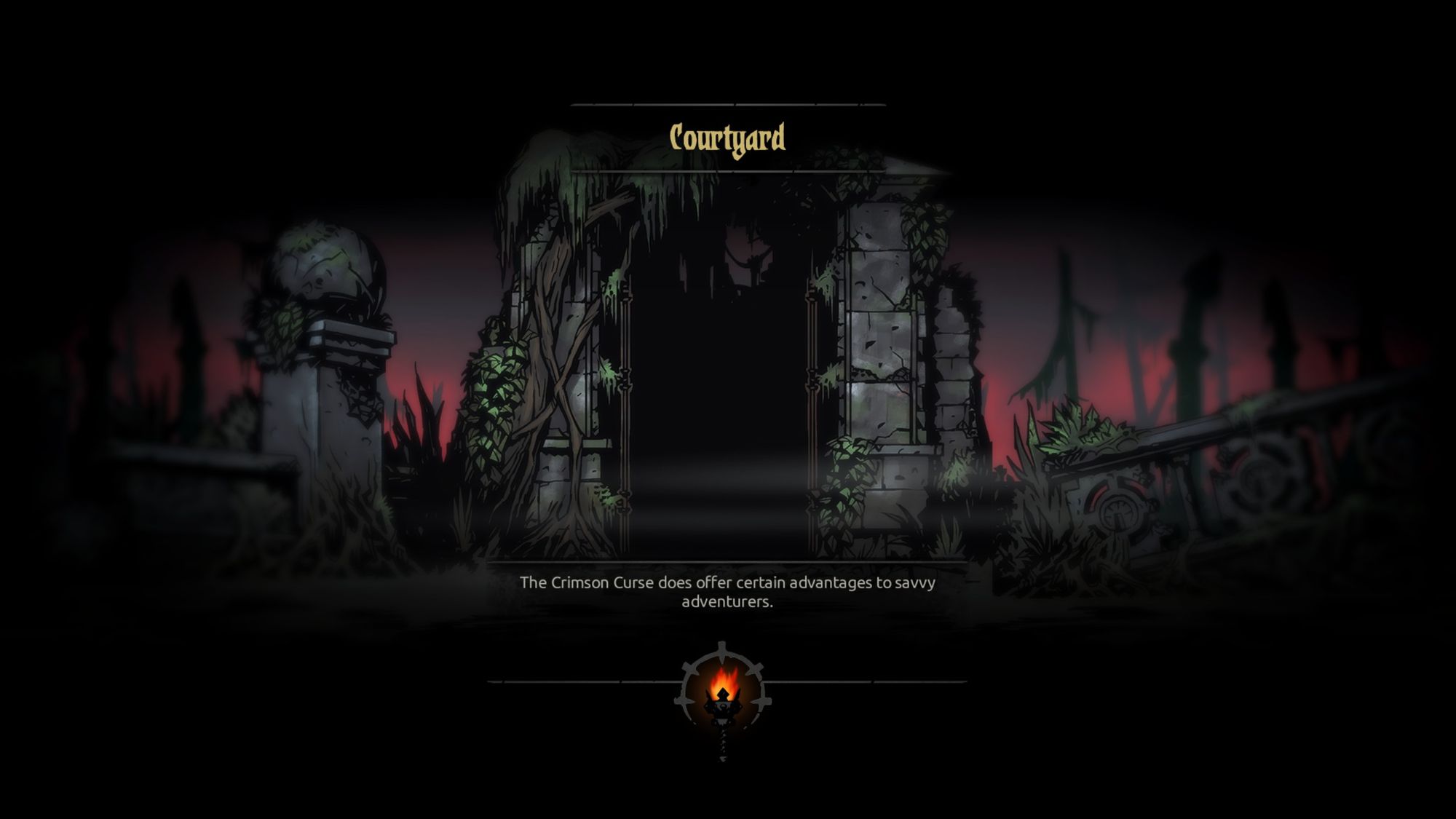
As the game continues on, more enemies escape from the courtyard and appear in the normal Darkest Dungeon areas - thus ensuring the Crimson Curse spreads amongst your heroes. The Crimson Curse is a dark reimagining of Vampirism and creates an obssession amongst your heroes with "The Blood" - requiring you to go on dangerous ventures into the courtyard to find more, unless you're prepared to let your heroes go thirsty. It also attracts unwanted attention - but I'll let you figure out what that means by yourself.
It also introduces a new type of building in the town, which you can only build with blueprints, which you get from defeating bosses. These buildings give you excellent bonuses, but they come at a steep cost. Which is not always achievable when you've got bills to and Heroes to keep from self-destructing mentally.
The art choices here are deliberate and evocative. Intended to mimick 18th century French nobles, but instead stylised as Mosquitoes and other Insect-like parasites, the Crimson Court is evocative and memorable.

It also features the hardest boss fights and levels outside of the Darkest Dungeon in the core game, so you had best come prepared for a fight. It introduces four new bosses, three which are directly story related and one which is optional (and very difficult, thanks for asking).
The Color of Madness, by comparison, is instead more of an epilogue instead of the Crimson Court's prequel. It introduces a new range of trinkets, further expanding gameplay possibilities and has a new infinite replayability mode, called the "Endless Harvest". The story deals with a meteorite that was summoned by the Ancestor that has arrived long after his departure. It corrupts all around it, including the peasants and a new mini-boss, the Miller. The Heroes must enter the Farm and purge those who were once human, who have instead been corrupted by the meteor's eerie light.
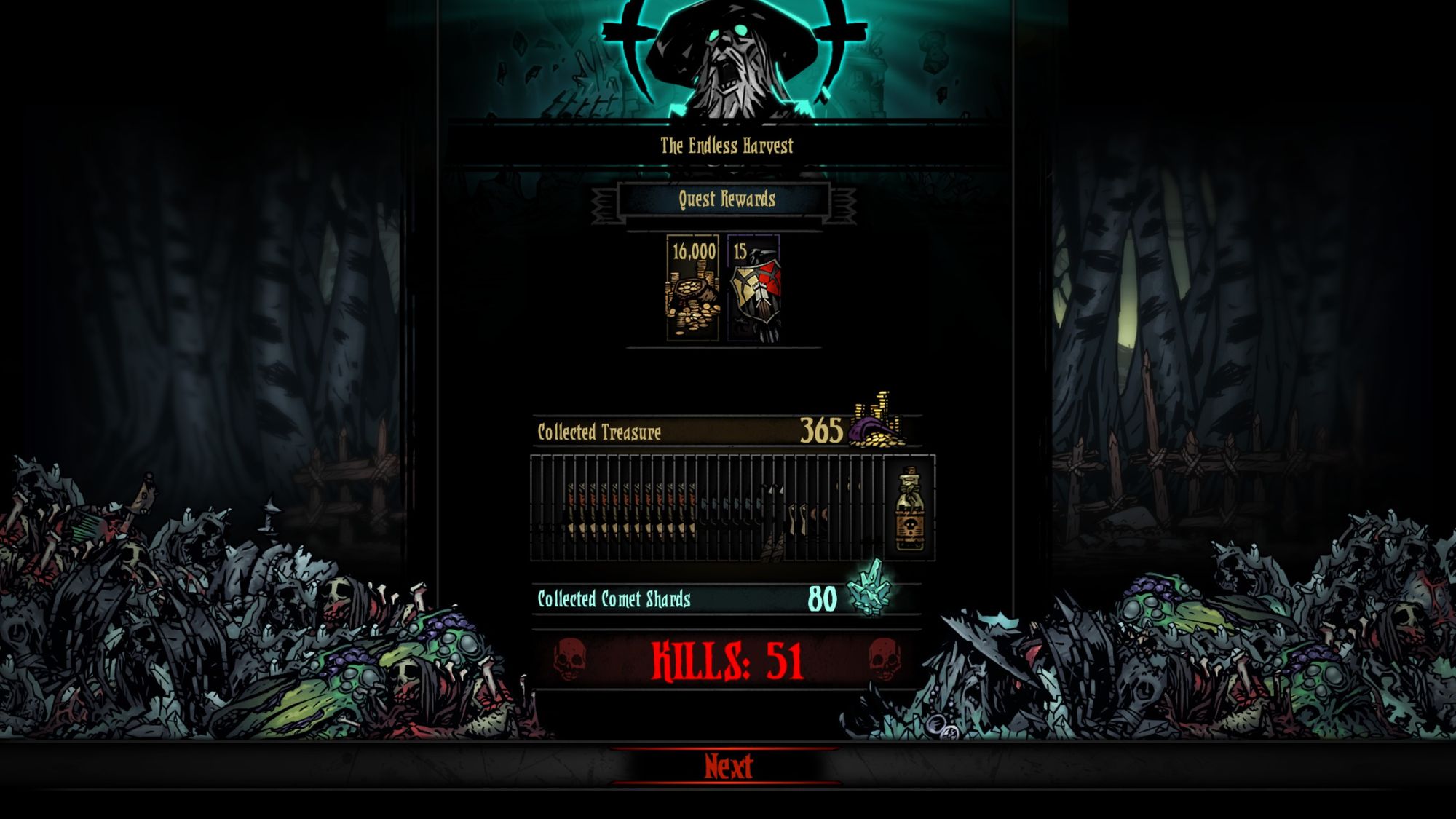
Where the Crimson Court and the Darkest Dungeon were about the worst excesses of the rich and powerful, the Color of Madness instead deals with the hopelessness of the common man and highlights how much the peasant is at the risk of the whims of the Ancestor. Both key additional themes and well thought out in their addition.
So that's Darkest Dungeon - a beautifully designed, well-crafted, totally immersive turn-based tactics RPG. Everything about the game is perfect - and as the great Jim Sterling said, there is no perfect video game, only perfect video games. And Darkest Dungeon is absolutely one of those. You can tell that it is put together with care and craft - and lovingly updated and adored by its developer. There's even PVP now, through a mini-expansion pack, entitled 'The Butcher's Circus' - which has a set of new soundtracks and is outstanding.
As for the boss-fight in the anecdote I mentioned at the start of the review? Well a week later I returned, prepared for combat and determined to beat the evil once and for all. And the rest, as they say, is history:

Gotcha, Bitch.
Catch you next time,
Vulkan
Did you like this article? Did you hate it? Go over and keep the discussion going on the official Vulkan's Corner facebook page! - whilst you're at it, leave a like!
